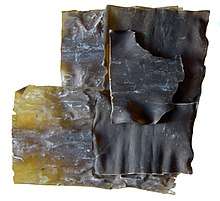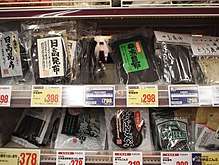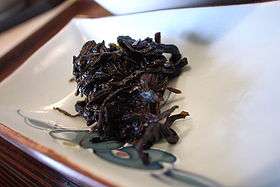Kombu


Kombu (from Japanese: 昆布, translit. konbu) is edible kelp from mostly the family Laminariaceae and is widely eaten in East Asia.[1] It may also be referred to as dasima (Korean: 다시마) or haidai (simplified Chinese: 海带; traditional Chinese: 海帶; pinyin: Hǎidài).
Prominent species
There are about eighteen edible species in Laminariaceae and most of them, but not all, are called kombu. Confusingly, species of Laminariaceae have multiple names in biology and in fisheries science. In the following list, fisheries science synonyms are in parentheses, and Japanese names follow them.
- Saccharina japonica (Laminaria japonica), Ma-kombu –
- Saccharina japonica var. religiosa (Laminaria religiosa), Hosome-kombu –
- Saccharina japonica var. diabolica (Laminaria diabolica), Oni-kombu –
- Saccharina japonica var. ochotensis (Laminaria ochotensis), Rishiri-kombu – commonly used for soup stocks
- Saccharina latissima (Laminaria saccharina), Karafuto-kombu – It contains mannitol and is considered sweeter.
- Saccharina angustata (Laminaria angustata), Mitsuishi-kombu – commonly used in the making of dashi
- Saccharina longissima (Laminaria longissima), Naga-kombu –
- Saccharina coriacea (Laminaria coriacea), Gaggara-kombu –
- Saccharina sculpera (Kjellmaniella sculpera), Gagome-kombu –
- Saccharina longipedalis (Laminaria longipedalis), Enaga-kombu –
- Saccharina gyrata (Kjellmaniella gyrata), tororo-kombu –
- Saccharina cichorioides (Laminaria cichorioides), Chijimi-kombu –
- Arthrothamnus bifidus, nekoashi-kombu –
Etymology
Kombu is a loanword from Japanese language.
In Old Japanese, edible seaweed was generically called "me" (cf. wakame, arame) and kanji such as "軍布",[2] 海藻[3] or "和布"[4] were applied to transcribe the word. Especially, kombu was called hirome (from hiroi, wide) or ebisume (from ebisu).[5] Sometime later the names konfu and kofu appeared respectively in two editions of Iroha Jirui Shō in 12th–13th century.[6]
Various theories have been claimed for the origin of the name kombu, with the following two predominant today.
One is that it originated from the On'yomi (Sino-Japanese reading) of the Chinese name 昆布 (kūnbù).[7] The kanji itself already could be seen in Shōsōin Monjo (8th century) and Shoku Nihongi (797) in Japan, and furthermore trace back in China, as early as 3rd century, to the book Wupu Bencao (around 239).[8] Li Shizhen wrote the following in his Bencao Gangmu (1596):
Come to think about it, Wupu Bencao says "綸布 (gūanbù), alias 昆布 (kūnbù)." Then, what is mentioned in the Erya as "(what is pronounced) 綸 resembles 綸. This is in the East China Sea" kūnbù. The pronouciation of 綸 is 関 (gūan), meaning cord made by blue thread, and got corrupted to 昆 (kūn).
— Li Shizhen, Bencao Gangmu[9]
Another possibility to explain the association arises because descriptions of kūnbù in Chinese documents are vague and inconsistent, and it is impossible to identify to which seaweed the term might have applied. For instance, Chen Cangqi (681–757) noted: "kūnbù is produced in the South China Sea; its leaf is like a hand and the size is the same as a silver grass and a reed, is of red purple; the thin part of leaf is seaweed",[9] which is similar to wakame, arame, kurome, or kajime (Ecklonia cava). The difficulty is that, at least in that time, kombu was not produced either in the East nor in the South China Sea. Moreover, following Zhang Yxi, Li Shizhen classified kūnbù and haidai (stands for kombu in Chinese) as different things,[9] and this classification continues in China today.[10]
A second possibility of origin is that the word originated from kompu, standing for kombu in the Ainu language.[11] Kompu in Ainu quite resembles gūanbù or kūnbù in Chinese, and it is possible to speculate that one is a loanword from the other.
History
"Qūan resembles 綸 (lace, cord or rope). This is in the East China Sea."[12] from the Erya (3rd–2nd century BC) and "Gūanbù, alias kūnbù" from the Wupu Bencao (3rd century). Tao Hongjing (456–536) noted kūnbù is edible.[9] As previously mentioned, however, kūnbù can not be identified with kombu. Zhang Yuxi referred to haidai in the book 嘉祐補註神農本草 (1060).[9]
Although archaeological evidence of seaweed is hard to find because of its easy decomposition, some plant remains of wakame seaweed are found in some ruins of the Jōmon Period[13] which leads to the supposition that kombu was also eaten at that time. As to surviving documents, the letters 軍布 (In Sino-Japanese reading 軍 is gun/kun ; 布 is fu/pu/bu) appeared in Man'yōshū and wood strips from Fujiwara-kyō, and may have indicated kombu. The Shoku Nihongi(797) reports: in 797 Suga no Komahiru of Emishi (Ainu or Tohoku region people) stated they had been offering up kombu, which grew there, as tribute to the Yamato court every year without fail. The Engishiki (927) also reports that kombu had been offered up by Mutsu.
During the Muromachi period, a newly developed drying technique allowed kombu to be stored for more than a few days, and it became an important export from the Tohoku area. By the Edo period, as Hokkaidō was colonized and shipment routes were organized, the use of kombu became widespread throughout Japan. Traditional Okinawan cuisine relies heavily on kombu as a part of the diet; this practice began in the Edo period. Okinawa uses more kombu per household than any other prefecture. In the 20th century, a way to cultivate kombu was discovered and it became cheap and readily available.
In 1867, the word "kombu" first appeared in an English-language publication—A Japanese and English Dictionary by James Curtis Hepburn.
Since the 1960s, dried kombu has been exported from Japan to many countries. It was available initially at Asian, and especially Japanese, food shops and restaurants, and can be found in supermarkets, health-food stores, and other nonspecializing suppliers.
Cooking
Japan
Kombu is sold dried (dashi konbu) or pickled in vinegar (su konbu) or as a dried shred (oboro konbu,tororo konbu or shiraga konbu). It may also be eaten fresh in sashimi.
Kombu is used extensively in Japanese cuisines as one of the three main ingredients needed to make dashi, a soup stock. Konbu dashi is made by putting either whole dried or powdered kombu in cold water and heating it to near-boiling. The softened kombu is commonly eaten after cooking or is sliced and used to make tsukudani, a dish that is simmered in soy sauce and mirin.
Kombu may be pickled with sweet-and-sour flavoring, cut into small strips about 5 or 6 cm long and 2 cm wide. These are often eaten as a snack with green tea. It is often included when cooking beans, putatively to add nutrients and improve their digestibility.
Konbu-cha or kobu-cha (昆布茶) is a tea made by infusing kombu in hot water. What Americans call kombucha is called "kocha kinoko" in Japan.[14]
Kombu is also used to prepare a seasoning for rice to be made into sushi.
Nutrition and health effects
Kombu is a good source of glutamic acid, an amino acid responsible for umami (the Japanese word used for a basic taste identified in 1908). Several foodstuffs in addition to kombu provide glutamic acid or glutamates.
Kombu contains extremely high levels of iodine. While this mineral is essential for normal growth and development, the levels in kombu can cause overdoses; it has been blamed for thyroid problems after drinking large amounts of soy milk in which kombu was an additive.[15]
It is also a source of dietary fiber. Algae including kombu also contain entire families[16] of obscure enzymes that break down complex sugars that are normally indigestible to the human gut (thus gas-causing), including the well-studied alpha-galactosidase and beta-galactosidase.[17]
Biofuel
Genetically manipulated E. coli bacteria can digest kombu into ethanol, making it a possible maritime biofuel source.[18][19]
See also
Notes
- ↑ Abbott, Isabella A (1989). "Food and food products from seaweeds". In Lembi, Carole A.; Waaland, J. Robert. Algae and human affairs. Cambridge University Press, Phycological Society of America. p. 141. ISBN 978-0-521-32115-0.
- ↑ Man'yōshū and wood strips from Fujiwara-kyō. Between late 7th and early 8th century
- ↑ Shōsōin Monjo (documents of Shōsōin; 8th century) and Fudoki.
- ↑ 色葉字類抄 (Iroha Jirui Shō); the vocabulary of Japanese and Chinese. Middle or late 12th century.
- ↑ 本草和名 (Honzō Wamyō) ; the oldest surviving dictionary of medicine in Japan. Early 10th century.
- ↑ The latter is revised and enlarged edition 伊呂波字類抄 (Iroha Jirui Shō). 13th century.
- ↑ 谷川士清 (Tanikawa Kotosuga) et al., 和訓栞 (Wakun no Shiori). 1777–1899.
- ↑ 吳普本草 (Wupu Bencao) is the Chinese materia medica work written by Wupu.
- 1 2 3 4 5 Li Shizhen, Bencao Gangmu
- ↑ Wang Cheyueh 王者悅 (ed.), 中国药膳大辞典 (Chinese Medicated Diet Dictionary), Dalian, Dalian Publishing House, 1992.
- ↑ Ōtsuki Fumihiko et al., Daigenkai. Tokyo, Fuzanbō, 1932–1937.
- ↑ 爾雅 (The Erya) 釋草(Commentaries on Grasses)
- ↑ 日本ひじき協議会 (Japan Hijiki Council)
- ↑ Wong, Crystal (12 July 2007). "U.S. 'kombucha': Smelly and No Kelp". Japan Times. Retrieved 14 June 2015. .
- ↑ "RACGP Health alert – high levels of iodine in BonSoy soy milk". Royal Australian College of General Practitioners. 24 December 2009. Archived from the original on August 18, 2010. Retrieved 3 November 2010.
- ↑ Hehemann, JH; Boraston, AB; Czjzek, M (2014). "A sweet new wave: structures and mechanisms of enzymes that digest polysaccharides from marine algae". Current Opinion in Structural Biology. 28: 77–86. doi:10.1016/j.sbi.2014.07.009. PMID 25136767.
- ↑ Bakunina, I. Yu; Nedashkovskaya, O. I; Kim, S. B; Zvyagintseva, T. N; Mikhailov, V. V (2012). "Diversity of glycosidase activities in the bacteria of the phylum Bacteroidetes isolated from marine algae". Microbiology. 81 (6): 688–695. doi:10.1134/S0026261712060033.
- ↑ Genetically Engineered Stomach Microbe Converts Seaweed into Ethanol, Scientific American, 2012-01-19
- ↑ An Engineered Microbial Platform for Direct Biofuel Production from Brown Macroalgae, Science, 2012-01-20
References
- Davidson, Alan. Oxford Companion to Food (1999), "Kombu", p. 435 ISBN 0-19-211579-0
- Culture of Kelp (Laminaria japonica) in China
- Hosking, Richard (1996). A dictionary of Japanese food: ingredients & culture. Tuttle Publishing. pp. 206–208. ISBN 978-0-8048-2042-4.
External links
| Wikimedia Commons has media related to Kombu. |



